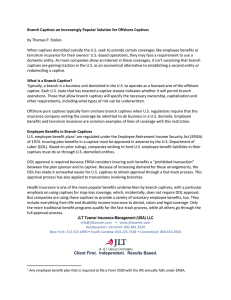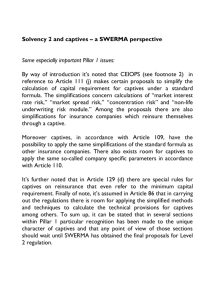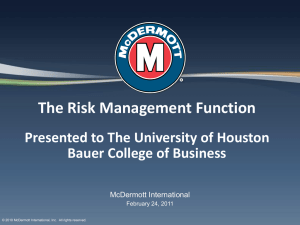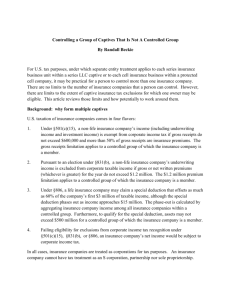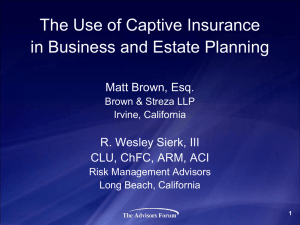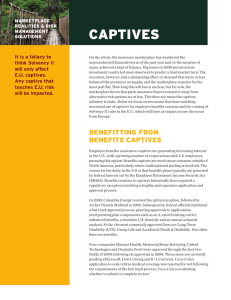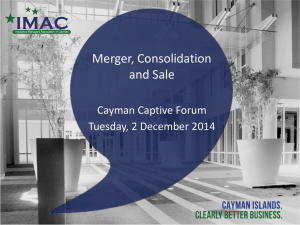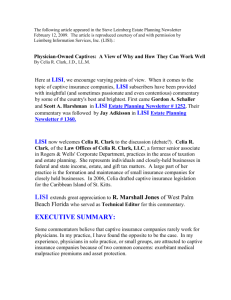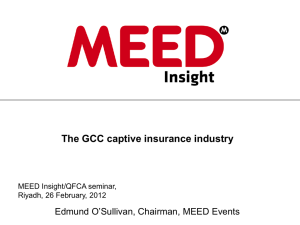Healthcare Captives - Past, Present & Future presentation files
advertisement
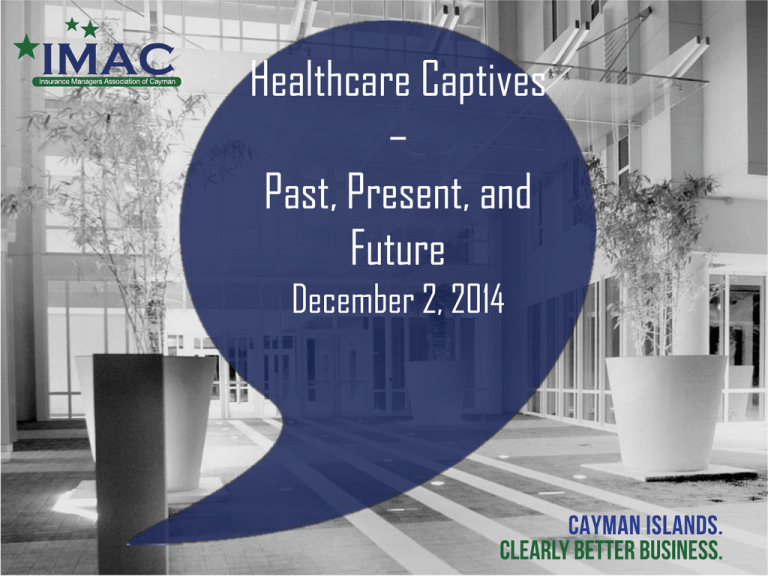
Healthcare Captives – Past, Present, and Future December 2, 2014 Tom Hermes: Towers Watson Julie Robertson: Honigman Miller Schwartz and Cohn LLP INTRODUCTION • The U.S. healthcare industry was an early adopter of captives and continues to be one of the largest industry segments that use captives. Why? • Market demands: coverage at times unavailable, unaffordable; hospitals forced to take high retentions • Desire to control the defense of claims, including having joint defense when nonemployed physicians were co-defendants • Favorable reimbursement treatment in the past • Now the industry is in a dramatic state of flux • We’ll address the evolution of captives, and the current state of the healthcare industry and its likely impact on existing captives and captive formations 3 PAST - THE HEALTHCARE INDUSTRY • Hospitals were the drivers • Mostly nonprofit, community based • Had the “big bucks” • Physicians were not employed by hospitals • Physicians generally practiced solo or in small groups • “Doctor’s Orders”; not a team approach to delivery of care • Most claims arose from incidents occurring in the hospital • Paper records; little outcomes data 4 PAST – EARLY CAPTIVE FORMATIONS • Late 70’s – Mid 80’s • Primarily hard market driven- availability/affordability • Individual hospitals or large unrelated groups • Primarily HPL and HGL coverages • Mid 80’s – Mid 2000’s • • • • • Still hard market driven-particularly doctors Non-employed physician-availability/affordability Also strategic as larger systems forming – need insurance vehicle Significant growth in Dr. captives (RRGs) as Dr. mutuals struggle Regional competition for independent doctors • Mid 2000’s – Present • Captive consolidation mirrors healthcare industry consolidation 5 PRESENT - THE HEALTHCARE INDUSTRY • The ship is turning • Affordable Care Act ▬ Resulting in significant increase in insured population ▬ Focus on population health management; goal is to improve health and keep population out of the acute care setting • Significant increase in hospital employment of physicians • Technological advances outpacing ability to manage and use data • Increasing merger and acquisition activity 6 PRESENT – UNCERTAINTY AFFECTS HEALTHCARE CAPTIVE PROGRAMS Worldwide economic instability continues Real and manufactured crises continue Affordable Care Act ▬ Potential changes to historical risks are not represented in current data ▬ Changes generate new potential causes of loss requiring coverage – no data Will professional liability still be the primary captive coverage? Cyber liability, EMR flaws, billing errors, fraud, restraint of trade Managed care, stop loss, pandemic issues (WC and liability), provider risk Insurance cycle turning?? Could affect availability/affordability 7 PRESENT – The Medical Professional Liability Cycle Is the Medical Professional Liability (MPL) insurance cycle turning?? Last MPL cycle turned positive in 2002 (13 years ago) – change is due Tort reform erosion continues Major healthcare restructuring creating potential new liability issues Never events (absolute liability?) Systematic risk (EMR System flaws) Government scrutiny/reporting requirements (Section III) (stents) Increased public awareness of outcomes (higher expectations) Some evidence that large claim severity is increasing (while frequency flat) Increased frequency of class action/batch cases (cardiac stents) 8 PRESENT – Hard Market Cycle Generally Required a “Perfect Storm” Substantial increases in frequency and/or severity of claims Early cycles were frequency driven Most recent cycle was large loss severity driven Significant decline in investment return affects leverage Excess market capacity limited (market demands high attachments/prices) Historically insureds buy down (per claim/agg. limits) during soft market ultimately resulting in significant working layer losses for excess market Adverse loss development on prior years loss reserves Cash flow underwriting allows loss ratios excess of 100% Often driven by late reserve development on large cases 2007 Example 9 PRESENT – Hard Market Cycle Generally Required a “Perfect Storm” (continued) While there is some evidence of increased severity of large claims, overall trend indications remain moderate (≤ 5%) Investment returns remain low but relatively stable Commercial underwriting is more stable – significant excess capacity As systems have formed, insureds have taken larger retentions with no aggregates – excess markets are not in the working layer Low investment income requires better underwriting Actuarial data improved substantially Claims reporting, settlement and payment patterns accelerated Increased healthcare risk management/safety focus has lowered trends Loss reserve development on prior years is still favorable (graphs) 10 Medical Malpractice Ultimate Loss Est. by Coverage Year/Valuation Date Source: SNL *Prior Years do not include data up to 2012 11 Medical Malpractice Ultimate Loss Est. by Coverage Year/Valuation Date (continued) Source: SNL *Prior Years do not include data up to 2013 12 LOOKING TOWARD THE FUTURE Mergers/Acquisitions/Affiliations/Partnerships/JOA’s/Management Agreements/Purchasing Arrangements Other healthcare systems/hospitals New types of providers in the system, including health plans Combining coverage for taxable/non-taxable/governmental entities Mergers result in multiple captives requiring consolidation New acquisition currently participates in a group captive with multi-year withdrawing commitments Deals negotiated without risk management involvement or review Diversity of coverage (system at $100M, affiliated/owned entity at $1M); new geographic areas Increasing D&O/antitrust risk? 13 LOOKING TOWARD THE FUTURE: DELIVERY OF SERVICE Physician “Employment”/Alignment Prior Acts Coverage for physicians Limits provided Responsibility for “rogue” physicians Taxable / tax-exempt risk Risk management experience with physicians Does 1 + 1 = 2 when physician risk shifts to hospital program? Do physicians want/need more involvement with captives? Team approach to delivery of services As the roles of midlevel providers increase, will their liability? ▬ How will the market respond? 14 LOOKING TOWARD THE FUTURE: POPULATION HEALTH Population Health Will the old managed care risks emerge again? Allegations: ▬ Provider has financial incentive NOT to provide care ▬ All members of the team are responsible ▬ ACO or similar organization liable for its policies and credentialing How will captives participate in financial risk? ▬ How will state and domicile regulators respond? ▬ Will commercial markets partner with captives? ▬ What tools are needed to assist in the understanding and management of this risk? 15 LOOKING TOWARD THE FUTURE: EMERGING RISKS While professional liability currently remains the primary focus of healthcare captives, other exposures will take on increased significance: Cyber / technology liability: privacy and security of health and financial information, social media, providing technology services for others, likelihood of batch claims resulting from system error Governmental fines and penalties: EMR allows for increased use of data in discovering and documenting issues, outliers D&O/E&O: for services provided to others too? For professional liability: Use of national standards/outcome data to set new standards of practice Branding: responsibility for the acts of nonowned/controlled entities Telemedicine 16 What Will All of This Mean for Captives? • • The industry isn’t status quo and the captive can’t be either M&A Activity: • • • Governance: • • • How to understand and incentivize risk reduction in population health? Structure: • • • If risk is changing, who should be involved with the captive? Consider agendas, reports and board education; how should the focus change? Risk Reduction: • • Is the captive following the lead of the parent in the integration strategy? Bumps in the road in the transitional process Does the captive need to be restructured to accommodate taxable/tax-exempt risk, third party risk? To segregate risk? Are multiple captives advantageous? Regulation • Watch for developments in regulation of financial risk, stop loss products, etc., and the impact on the captive 17 Don’t Forget the Mission Captive Mission Statement (in 10 words or less) Minimize risk Minimize cost of risk Support parent business (mission) 18 When Considering Coverage for Evolving Risks Don’t risk a lot to save a little Retain risk that is controllable and predictable Transfer risk that is volatile or unpredictable Retain “owned” risk and transfer “non-owned” risk 19 The Best News Captives are part of the fabric of risk in healthcare organizations Captives are not “alternative” any longer New models/structures provide significant flexibility More guidance on tax issues than in prior years Captives have proved to be adaptable in the past and will in the future 20 21
